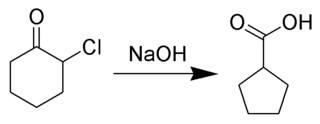An ylide or ylid is a neutral dipolar molecule containing a formally negatively charged atom (usually a carbanion) directly attached to a heteroatom with a formal positive charge (usually nitrogen, phosphorus or sulfur), and in which both atoms have full octets of electrons. The result can be viewed as a structure in which two adjacent atoms are connected by both a covalent and an ionic bond; normally written X+–Y−. Ylides are thus 1,2-dipolar compounds, and a subclass of zwitterions. They appear in organic chemistry as reagents or reactive intermediates.

In organic chemistry, an amino sugar is a sugar molecule in which a hydroxyl group has been replaced with an amine group. More than 60 amino sugars are known, with one of the most abundant being N-acetyl-D-glucosamine, which is the main component of chitin.
In organic chemistry, a sigmatropic reaction is a pericyclic reaction wherein the net result is one sigma bond (σ-bond) is changed to another σ-bond in an intramolecular reaction. In this type of rearrangement reaction, a substituent moves from one part of a π-system to another part with simultaneous rearrangement of the π-system. True sigmatropic reactions are usually uncatalyzed, although Lewis acid catalysis is possible. Sigmatropic reactions often have transition-metal catalysts that form intermediates in analogous reactions. The most well-known of the sigmatropic rearrangements are the [3,3] Cope rearrangement, Claisen rearrangement, Carroll rearrangement, and the Fischer indole synthesis.
The Wittig reaction or Wittig olefination is a chemical reaction of an aldehyde or ketone with a triphenyl phosphonium ylide called a Wittig reagent. Wittig reactions are most commonly used to convert aldehydes and ketones to alkenes. Most often, the Wittig reaction is used to introduce a methylene group using methylenetriphenylphosphorane (Ph3P=CH2). Using this reagent, even a sterically hindered ketone such as camphor can be converted to its methylene derivative.

The Claisen rearrangement is a powerful carbon–carbon bond-forming chemical reaction discovered by Rainer Ludwig Claisen. The heating of an allyl vinyl ether will initiate a [3,3]-sigmatropic rearrangement to give a γ,δ-unsaturated carbonyl, driven by exergonically favored carbonyl CO bond formation Δ(ΔfH) = −327 kcal/mol (−1,370 kJ/mol).

The Favorskii rearrangement is principally a rearrangement of cyclopropanones and α-halo ketones that leads to carboxylic acid derivatives. In the case of cyclic α-halo ketones, the Favorskii rearrangement constitutes a ring contraction. This rearrangement takes place in the presence of a base, sometimes hydroxide, to yield a carboxylic acid, but usually either an alkoxide base or an amine to yield an ester or an amide, respectively. α,α'-Dihaloketones eliminate HX under the reaction conditions to give α,β-unsaturated carbonyl compounds. Note that trihalomethyl ketone substrates will result in haloform and carboxylate formation via the haloform reaction instead.
The Meyer–Schuster rearrangement is the chemical reaction described as an acid-catalyzed rearrangement of secondary and tertiary propargyl alcohols to α,β-unsaturated ketones if the alkyne group is internal and α,β-unsaturated aldehydes if the alkyne group is terminal. Reviews have been published by Swaminathan and Narayan, Vartanyan and Banbanyan, and Engel and Dudley, the last of which describes ways to promote the Meyer–Schuster rearrangement over other reactions available to propargyl alcohols.
Luche reduction is the selective organic reduction of α,β-unsaturated ketones to allylic alcohols. The active reductant is described as "cerium borohydride", which is generated in situ from NaBH4 and CeCl3(H2O)7.
A chemical glycosylation reaction involves the coupling of a glycosyl donor, to a glycosyl acceptor forming a glycoside. If both the donor and acceptor are sugars, then the product is an oligosaccharide. The reaction requires activation with a suitable activating reagent. The reactions often result in a mixture of products due to the creation of a new stereogenic centre at the anomeric position of the glycosyl donor. The formation of a glycosidic linkage allows for the synthesis of complex polysaccharides which may play important roles in biological processes and pathogenesis and therefore having synthetic analogs of these molecules allows for further studies with respect to their biological importance.
The Ferrier carbocyclization is an organic reaction that was first reported by the carbohydrate chemist Robert J. Ferrier in 1979. It is a metal-mediated rearrangement of enol ether pyrans to cyclohexanones. Typically, this reaction is catalyzed by mercury salts, specifically mercury(II) chloride.

The armed/disarmed approach to glycosylation is an effective way to prevent sugar molecules from self-glycosylation when synthesizing disaccharides. This approach was first recognized when acetylated sugars only acted as glycosyl acceptors when reacted with benzylated sugars. The acetylated sugars were termed “disarmed” while the benzylated sugars were termed “armed”.
The Tipson–Cohen reaction is a name reaction first discovered by Stuart Tipson and Alex Cohen at the National Bureau of Standards in Washington D.C. The Tipson–Cohen reaction occurs when two neighboring secondary sulfonyloxy groups in a sugar molecule are treated with zinc dust (Zn) and sodium iodide (NaI) in a refluxing solvent such as N,N-dimethylformamide (DMF) to give an unsaturated carbohydrate.
The Crich β-mannosylation in organic chemistry is a synthetic strategy which is used in carbohydrate synthesis to generate a 1,2-cis-glycosidic bond. This type of linkate is generally very difficult to make, and specific methods like the Crich β-mannosylation are used to overcome these issues. The technique takes its name from its developer, Professor David Crich.
The [2,3]-Wittig rearrangement is the transformation of an allylic ether into a homoallylic alcohol via a concerted, pericyclic process. Because the reaction is concerted, it exhibits a high degree of stereocontrol, and can be employed early in a synthetic route to establish stereochemistry. The Wittig rearrangement requires strongly basic conditions, however, as a carbanion intermediate is essential. [1,2]-Wittig rearrangement is a competitive process.
An insertion reaction is a chemical reaction where one chemical entity interposes itself into an existing bond of typically a second chemical entity e.g.:
UDP-4-amino-4,6-dideoxy-N-acetyl-alpha-D-glucosamine transaminase is an enzyme with systematic name UDP-4-amino-4,6-dideoxy-N-acetyl-alpha-D-glucosamine:2-oxoglutarate aminotransferase. This enzyme catalyses the following chemical reaction
UDP-N-acetylglucosamine 4,6-dehydratase (configuration-inverting) (EC 4.2.1.115, FlaA1, UDP-N-acetylglucosamine 5-inverting 4,6-dehydratase, PseB, UDP-N-acetylglucosamine hydro-lyase (inverting, UDP-2-acetamido-2,6-dideoxy-β-L)arabino-hex-4-ulose-forming)) is an enzyme with systematic name UDP-N-acetyl-α-D-glucosamine hydro-lyase (inverting; UDP-2-acetamido-2,6-dideoxy-β-L-arabino-hex-4-ulose-forming). This enzyme catalyses the following chemical reaction
UDP-N-acetylglucosamine 4,6-dehydratase (configuration-retaining) (EC 4.2.1.135, PglF) is an enzyme with systematic name UDP-N-acetyl-α-Dglucosamine hydro-lyase (configuration-retaining; UDP-2-acetamido-2,6-dideoxy-α-Dxylo-hex-4-ulose-forming). This enzyme catalyses the following chemical reaction

Robert John Ferrier FRSNZ, FNZIC, was an organic chemist who discovered two chemical reactions, the Ferrier rearrangement and the Ferrier carbocyclization. Originally from Edinburgh, he moved to Wellington, New Zealand, in 1970.







